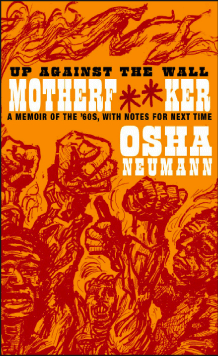By Jericho Parms
From the abandoned squats and rundown tenements, a longhaired band of lost young souls roamed the streets of the Lower East Side. Opting out of peace-loving fringes, they pocketed switchblades in their black leather jackets, denounced “Flower Power” in the name of “Armed Love,” and touted mimeographed flyers bearing angry manifestos. They were simply, crudely, locally—the Motherf**kers.
In his new memoir, “Up Against the Wall Motherf**ker: A Memoir of the ’60s with Notes for Next Time,” Osha Neumann tells the story of this “street gang with an analysis.”
Though never destined for national recognition, this loosely knit enclave of artists, punks, and ivy-league dropouts, may have seeded the radical Weathermen. They commiserated with the hippies, had little patience for Yippie antics, and maintained a prickly relationship with SDS and leaders of the New Left. Founded in 1967, from a Dadaist art group led by anarchist painter Ben Morea, the Motherf**kers were most akin to the Diggers of San Francisco, with a gritty, urban edge.
This was, after all, the Lower East Side in the 1960s, which Neumann describes in an eloquent eulogy as a crowded pool of ethnicity and creative misfits. The bulk of Jewish immigrants had “moved on to bigger things,” leaving mostly Puerto Ricans. Old Ukrainians “dozed on the benches in Tompkins Square Park, spat occasionally… and worried about the neighborhood.” The streets teemed with “poets, jazz musicians, and painters driven from Greenwich Village by rising rents.”
Taking their name from a Leroi Jones poem, The Motherf**kers carved out an illusive status as the street gang “with the unspeakable name.” Marked by their inflammatory rhetoric, they sought a fierce political identity enforced by anarchist tactics and destructive revelry. Proclaiming “garbage for garbage” as the true cultural exchange, they carried trash from the East Village to the steps of Lincoln Center during the sanitation strike of 1968. They rallied to endorse Valerie Solanas after she shot Andy Warhol, declared war on the legendary Fillmore East, demanding free use of the space for the community, and battled through Federal Marshalls as Abbie Hoffman and the Yippies chanted to “levitate the Pentagon” in a ring of peace.
The story of the Motherf**kers is open to criticism, yet it is perhaps best understood through Neumann’s own ferocious retrospect. These young white radicals raged against the alienating forces of a capitalist culture they were born into, upholding a belief in the propaganda of the deed. The impending sense of apocalypse fueled much of the anti-war effort and may have arguably led them barreling blindly through the complex obstacles inherent to their fair-skinned revolution, in the same way it lead to the Weathermen’s eventual turn to armed struggle in the 1970s.
Neumann’s narrative spans the group’s inception on the Lower East Side to their refuge and demise in New Mexico while incorporating his own personal journey. Born of German Jewish intellectuals, he rebelled against the rigid analytic framework of his childhood, finding self-satisfaction as an artist and freedom in the communes of California. Nearly three quarters of the way through the book, Neumann abandons his account of his days as a Motherf**ker, and his remaining pages are consumed with inner debate. However, before veering too close to an uncomfortable soul-search, revealing his battles with a self-degraded identity, Neumann offers cunning analysis of counter-culture, art, and revolution.
Now a prominent lawyer and still an activist, Neumann dismisses the Motherf**kers’ tactics as arrogant and ineffective, mere “childish tantrums,” yet wholeheartedly believes in the need to disentangle their story “as one would a bird caught in a net.” The success of the group, like that of the Weathermen, was largely limited by their die-hard refusal to compromise street credit for greater legitimacy. Neumann offers no conclusive understanding of this group that may have done little but harness the raw energy of the Lower East Side into a passage in history. Yet, in as much as it was self-defeating, their radicalism was sincere, and provides context for the paranoia and volatility of a time, the enduring myths and polarizing perceptions of what the countless radical groups were all about. New York’s Motherf**kers are perhaps the least documented and the most esoteric among them. Neumann’s memoir is the first full account of the group and colorful dose of “flower power, with thorns.”
Osha Neumann will be reading from his book at Bluestockings Bookstore (172 Allen St., 212-777-6028) on Fri., Jan. 30 at 7 p.m. and with Judith Malina at The Living Theatre (21 Clinton St., 212-792-8050), as part of the LBC Anarchist Forums, on Sat. Jan. 31 at 2 p.m.

































